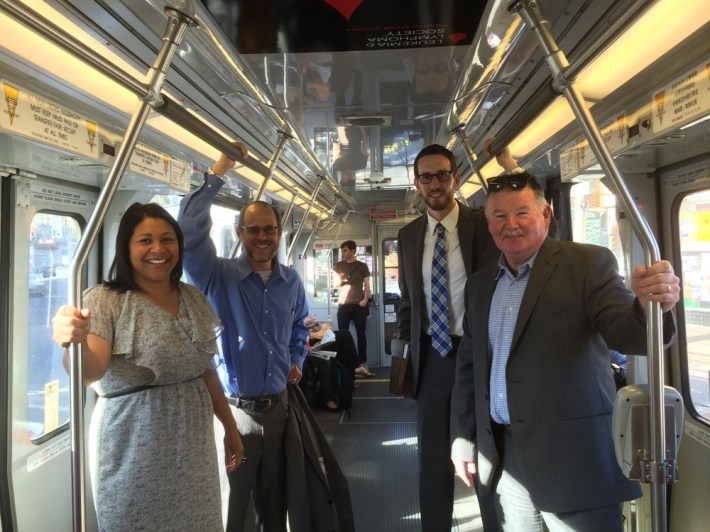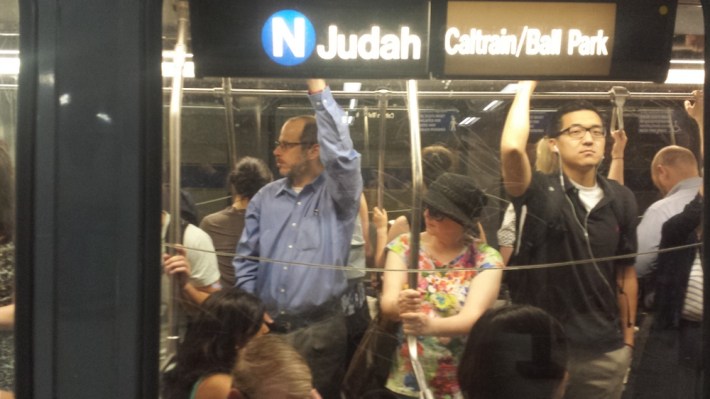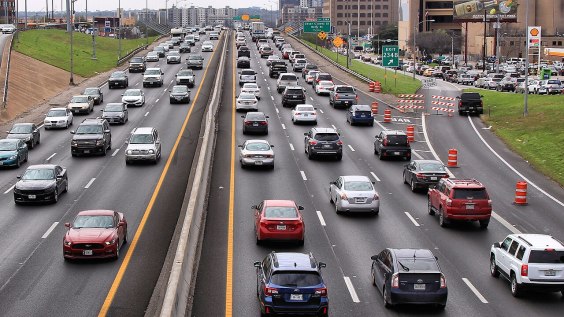A Muni train car re-configured with fewer seats and more standing room was put into Metro service this week. According to the SFMTA, 14 "double-wide" seats were replaced with "single-wide" seats, adding a net capacity gain of "at least ten" riders to the car, which is a pilot project to squeeze more capacity onto Muni's trains.
SFMTA officials, along with Supervisors London Breed and Scott Wiener, rode the car on the N-Judah yesterday morning. I was also supposed to be there, but in regular Muni fashion, the train wasn't on time -- in fact, it was inexplicably half an hour early. Fortunately, Breed's office passed along some rare photos of public officials riding Muni.
While Muni riders wait for a fleet of 200 new train cars, "I am committed to doing everything possible to help Muni riders, and I look forward to hearing directly from them about this pilot design,” said Breed in a statement. "This design will create more space for Muni riders, who are too often forced to wedge onto full trains or wait at the station in hope for room on the next one."

Breed and Wiener called for Muni to test out seat re-configurations last September. The prototype car was supposed to launch in January, but was delayed for unknown reasons. The SFMTA says the train will run for a month, on the N-Judah until Friday, May 30th, and on the L-Taraval from Monday, June 2 to Friday, June 13.
Transit advocates say the $30,000 pilot is a worthwhile way to relieve overcrowding, but only a stopgap measure that points to Muni's deeper problems.
"Muni is experiencing record ridership but [not an] increase in its fleet, contributing to increased overcrowding," said Mario Tanev of the SF Transit Riders Union. "Thus, given the limitations, it makes sense to try to reconfigure existing vehicles to allow more passengers, as long it is done safely, and [maintains] the ability for those in need of a seat to be able to be seated. However, it also shows clearly how Muni under-investment is pressing riders like sardines into cans."
"It's a decent short-term fix. The problem is that Muni doesn't have a long-term fix," said Tom Radulovich, executive director of Livable City and a member of the BART Board of Directors. Although the Muni Transit Effectiveness Project includes some mild infrastructure improvements for the N and J-Church lines, like transit-only lanes and signal priority, Radulovich says fundamental design flaws of the streetcar system remain unaddressed.
Muni has no plans "to look at doing what we should do, which is convert our combination streetcar-plus-metro system into a much more modern streetcar system," said Radulovich. "That might mean low-floor vehicles, a lot more dedicated" transit lanes.
Removing seats means that more riders will have a chance to stand, and more will have to stand. As Radulovich said, though, "the good news" is the riders who board earliest and ride the longest distances are most likely to get seats.
The consensus among Tanev, Supervisor Wiener, and Muni Director of Operations John Haley is that the transportation funding measures headed to the ballot are crucial to allowing the SFMTA to buy new light-rail trains and implement TEP upgrades.
“As our population grows, it will be challenging to accommodate Muni’s growing ridership," said Wiener in a statement. "This modest seat reconfiguration, which will create more standing room while allowing those who need a seat to sit, is a great short-term solution for Muni’s ongoing crowding problem."
"We have to be creative about how we address the challenges our riders are faced with every single day," said Haley.






